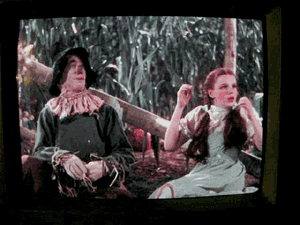TV System Flicker Comparison
The table below compares speed and flicker characteristics of various television systems. You'll notice that the table includes both field-sequential and simultaneous color systems.
| Model | FPS | Speed Comparison | Flicker rating |
| Col-R-Tel, 3 colors* | 10 | 100% | D |
| Col-R-Tel, 2 colors* | 30 | 300% | A |
|
Apollo color mooncam* (on moon) |
10 | 100% | D |
|
Apollo color mooncam (post-conversion) |
30 | 300% | A |
| Spectrac* | 30 | 300% | A |
| Color-AT&T | 16 | 160% | C |
| CBS* | 24 | 240% | B |
| PAL | 25 | 250% | B |
| NTSC | 30 | 300% | A |
| Chromacoder* | 30 | 300% | A |
|
*Indicates field-sequential. Rest are simultaneous color systems. Notes
Flicker Ratings
|
|||
2.5-Color TVWhat is 2.5-color TV? This is my name for an idea by Dave Ingram K4TWJ. Dave hatches his unique color scheme on page 189 of his Slow-Scan TV Handbook. The idea of 2.5 is to transmit a picture in two primary colors. But you reproduce the picture in three primary colors. In this system, the third color doesn't derive from the other two colors. Some background. These days, Dave's book is a very old but still very informative. Inside are details of a bygone TV hardware system. In 1977 or so, Ingram and others were improving the original, Copthorne Macdonald slow-scan system. Macdonald invented the system in 1958 and with his buddies refined it for about ten years. Later Macdonald became an editor of Mother Earth News. |
 Benham 2-color TV displays Dorothy and Scarecrow from The Wizard of Oz. Mouse over for
Munchkins.
Benham 2-color TV displays Dorothy and Scarecrow from The Wizard of Oz. Mouse over for
Munchkins.
|
SSTV specs. By 1968, SSTV was an FM, still-picture TV system. Ten years after that, hams digitized the system. Today, software replaces most of the dedicated hardware. Anyway, the SSTV spectrum occupies a ham radio voice band. This band runs from 300 to 3,000 Hz. Analog SSTV is an FM picture signal without audio. The usual method is to superimpose an FM subcarrier on an SSB signal. Hams call the modulation method SCFM, or subcarrier frequency modulation. The FM subcarrier is at 2300 Hz. The lowest frequency, sync, is 1200 Hz. Picture black is 1500 Hz. Picture white is 2300 Hz. In the classic standard, frames of 120 lines transmit in about 8 seconds. (That's 8.5 seconds for computer-generated frames of 128 lines.)
Today, new slow-scan modes replace this original mode. The new modes such as Scottie-1 and Martin-1 offer color and better definition. In fact, these two modes each provide about four times the definition of classic Macdonald mode. There's no free lunch, though: Transmission time is far longer, too. Yet analog slow-scan TV still uses the same SCFM subcarrier frequencies.
How 2.5-color SSTV works. Anyway, on to 2.5-color SSTV. When he published, Ingram speculated about means of colorizing SSTV. One of his color methods was this "2.5-color TV." In this system, you transmit the green and red signals on subcarriers. Then at the receiver, you apply these detected signals to the CRT guns. You drive the blue gun with a very weak, adjustable DC level. This level covers the picture with a blue tint. In Ingram's theory, the blue tint simulates true blue. Of course blue only makes up 10 percent of a color picture. The idea is that a DC level might trick the eye into seeing full color.
Mechanical 2.5-color TV is possible, too. For instance, imagine a color wheel with red and green wedges. This wheel scans your TV. Viewing the red and green picture through a blue transparency adds the third color. Instead of adjusting a DC level, you swap transparency densities until you find the best one.
See...
The Complete Handbook of Slow-Scan TV.
For more about two-color theory, see our page Define TV Luminance in Terms of 2 Complementary Colors.
Go to Page: 1 2 3 4 5 6 7 8 9 Next
Page Directory
On this page...TV System Flicker Comparison 2.5-Color TV
On related pages...
What is Two-Color TV? Col-R-Tel vs. Spectrac Two-Color TV History Gould Television: 3D from the Great Depression Gould 3D: Could It Work? Gould 3D: Camera & Monitor Formulas The Lost Creations of Leslie Gould Spectrac: Color for a Monochrome World